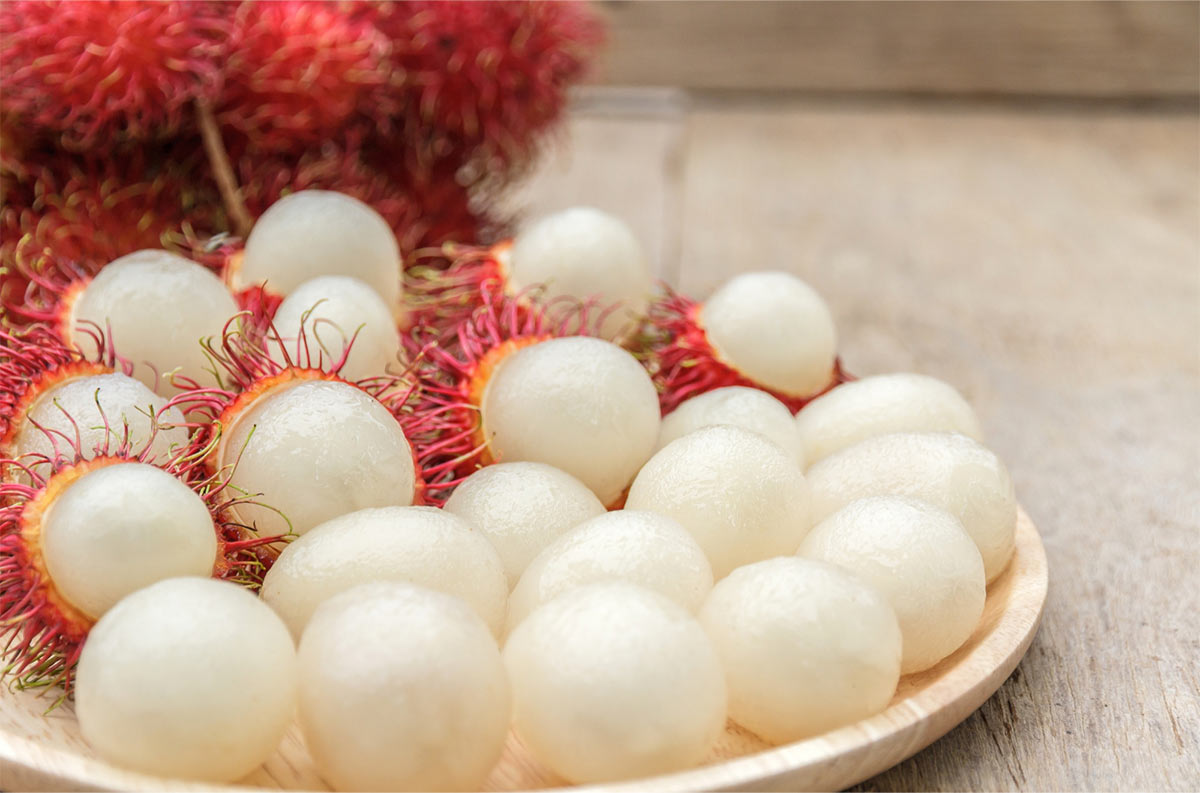

Rambutan, a tropical fruit native to Southeast Asia, has a hairy, spiky exterior and sweet, juicy flesh that is treasured amongst locals. The rambutan harvest season is typically around May, June and July, though off-season harvests are happening more frequently.
This exotic fruit is not only a delight to the taste buds but also packed with several health benefits. Let’s explore everything there is to know, including what it is, its nutritional composition, and how it can support various health goals.
Rambutan (Nephelium lappaceum) is a tropical fruit closely related to the lychee and longan. It grows on trees native to Southeast Asia, with its hairy, red or yellow outer shell housing juicy white or translucent flesh inside. The flavour of rambutan is often described as a blend of sweetness and a mild sour note, making it a popular ingredient in fruit salads, desserts, and juices. Due to its unique appearance and delicious taste, the fruit has garnered international attention, and the health benefits of rambutans are also widely recognised.
The nutritional value of rambutan is impressive, boasting several essential vitamins and minerals. It is a good source of vitamin C, which helps boost the immune system, and contains small amounts of iron, calcium, and phosphorus.
Additionally, rambutan is low in calories, making it a great option for guilt-free snacking.
Is rambutan good for digestion? Yes, it also contains a good amount of fibre, which is beneficial for digestion and maintaining a healthy gut.
Given the many health benefits of rambutan and its delicious tropical taste, you might be wondering how many you can get away with consuming in a day. While the fruit is packed with nutrients, it’s essential to enjoy it in moderation as it can mildly irritate the throat.
For most adults, 5-10 rambutan fruits per day is a safe and reasonable amount to consume. Eating this quantity provides a healthy dose of vitamin C, fibre, and antioxidants without overloading on sugar, especially if you’re keeping an eye on calorie intake.
Explore some of the key health facts of this tropical fruit:
The fruit has a relatively low glycemic index, meaning it doesn’t cause rapid spikes in blood sugar levels. The fibre in rambutan helps slow the absorption of sugar in the bloodstream, making it a suitable fruit for individuals managing diabetes.
The fruit is rich in vitamin C and antioxidants, which help protect the skin from free radical damage. The benefits of rambutan for the skin include hydration, improved elasticity, and reduced signs of ageing. Similarly, the benefits of rambutan for hair include strengthening the hair follicles and promoting hair growth due to its high water content and vitamins.
Can rambutan help with weight loss? The answer is yes. Due to its high water and fibre content, rambutan helps promote feelings of fullness, reducing the temptation to snack on unhealthy foods. Its low-calorie count makes it an excellent option for satisfying sweet cravings without contributing to weight gain.
While it’s fairly impossible to eat rambutan seeds on accident, as they are fairly large like many stone fruits, consuming them could lead to discomfort. Rambutan seeds can be mildly toxic if consumed raw. Additionally, the side effects of eating rambutan seeds may include stomach discomfort or indigestion if eaten accidentally.

The uses of Rambutans are as endless as imagination itself! It is highly versatile and can be used in a variety of recipes. You can eat it fresh as a snack, add it to fruit salads, or mix it into smoothies for a tropical twist. It also pairs well with desserts like ice cream, puddings, and fruit sorbets. For savoury dishes, rambutan can be used in salsas or as a topping for grilled meats, offering a refreshing contrast of sour-sweetness to rich flavours.
Whether you’re looking to boost your immune system, add hydration to your skin, or support weight loss, this tropical fruit delivers.
If you’re a business looking to invest in the ever-growing demand for organically grown, high-quality tropical fruits, Miditer is the right partner for you. Miditer’s Organic Rambutan in Pineapple Juice is a must-have secret weapon ingredient in any health-conscious person’s kitchen, for delicious, interesting meals that fit any kind of lifestyle.
If you’re curious about how you can collaborate with Miditer to deliver high-quality, organic rambutan products that align with today’s health-conscious market, consider partnering with us.
Is Rambutan Lychee?
Although rambutan and lychee are closely related, they are different fruits. Rambutan has a hairy outer shell, while lychee has a smoother, spiky exterior. Both fruits have similar sweet flavours, but rambutan’s taste is slightly more creamy.
Where is Rambutan originally from?
Rambutan is native to Southeast Asia, specifically regions like Malaysia, Indonesia, and Thailand. It thrives in tropical climates and is now grown in other parts of the world with similar weather conditions.
How to eat rambutan without the seed and skin?
To eat rambutan, use a knife to score the outer shell. Twist it open and remove the flesh from the seed. Make sure to discard the seed, as it is not edible in raw form.